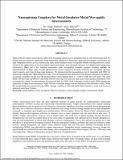| dc.contributor.author | Onbasli, Mehmet Cengiz | |
| dc.contributor.author | Okyay, Ali K. | |
| dc.date.accessioned | 2013-04-04T19:33:56Z | |
| dc.date.available | 2013-04-04T19:33:56Z | |
| dc.date.issued | 2010-08 | |
| dc.identifier.issn | 0277-786X | |
| dc.identifier.uri | http://hdl.handle.net/1721.1/78297 | |
| dc.description.abstract | State-of-the-art copper interconnects suffer from increasing spatial power dissipation due to chip downscaling and RC delays reducing operation bandwidth. Wide bandwidth, minimized Ohmic loss, deep sub-wavelength confinement and high integration density are key features that make metal-insulator-metal waveguides (MIM) utilizing plasmonic modes attractive for applications in on-chip optical signal processing. Size-mismatch between two fundamental components (micron-size fibers and a few hundred nanometers wide waveguides) demands compact coupling methods for implementation of large scale on-chip optoelectronic device integration. Existing solutions use waveguide tapering, which requires more than 4λ-long taper distances. We demonstrate that nanoantennas can be integrated with MIM for enhancing coupling into MIM plasmonic modes. Two-dimensional finite-difference time domain simulations of antennawaveguide structures for TE and TM incident plane waves ranging from λ = 1300 to 1600 nm were done. The same MIM (100-nm-wide Ag/100-nm-wide SiO2/100-nm-wide Ag) was used for each case, while antenna dimensions were systematically varied. For nanoantennas disconnected from the MIM; field is strongly confined inside MIM-antenna gap region due to Fabry-Perot resonances. Major fraction of incident energy was not transferred into plasmonic modes. When the nanoantennas are connected to the MIM, stronger coupling is observed and E-field intensity at outer end of core is enhanced more than 70 times. | en_US |
| dc.language.iso | en_US | |
| dc.publisher | SPIE--the International Society for Optical Engineering | en_US |
| dc.relation.isversionof | http://dx.doi.org/10.1117/12.876177 | en_US |
| dc.rights | Article is made available in accordance with the publisher's policy and may be subject to US copyright law. Please refer to the publisher's site for terms of use. | en_US |
| dc.source | SPIE | en_US |
| dc.title | Nanoantenna couplers for metal-insulator-metal waveguide interconnects | en_US |
| dc.type | Article | en_US |
| dc.identifier.citation | Onbasli, M. Cengiz, and Ali K. Okyay. “Nanoantenna Couplers for Metal-insulator-metal Waveguide Interconnects.” Proc. SPIE 7757, Plasmonics: Metallic Nanostructures and Their Optical Properties VIII,(September 10, 2010) Ed. Mark I. Stockman. 2010. 77573R–77573R–11. CrossRef. Web.© (2010) COPYRIGHT SPIE--The International Society for Optical Engineering. | en_US |
| dc.contributor.department | Massachusetts Institute of Technology. Department of Materials Science and Engineering | en_US |
| dc.contributor.mitauthor | Onbasli, Mehmet Cengiz | |
| dc.relation.journal | Proceedings of SPIE--the International Society for Optical Engineering | en_US |
| dc.eprint.version | Final published version | en_US |
| dc.type.uri | http://purl.org/eprint/type/JournalArticle | en_US |
| eprint.status | http://purl.org/eprint/status/PeerReviewed | en_US |
| dspace.orderedauthors | Onbasli, M. Cengiz; Okyay, Ali K. | en_US |
| mit.license | PUBLISHER_POLICY | en_US |
| mit.metadata.status | Complete | |
